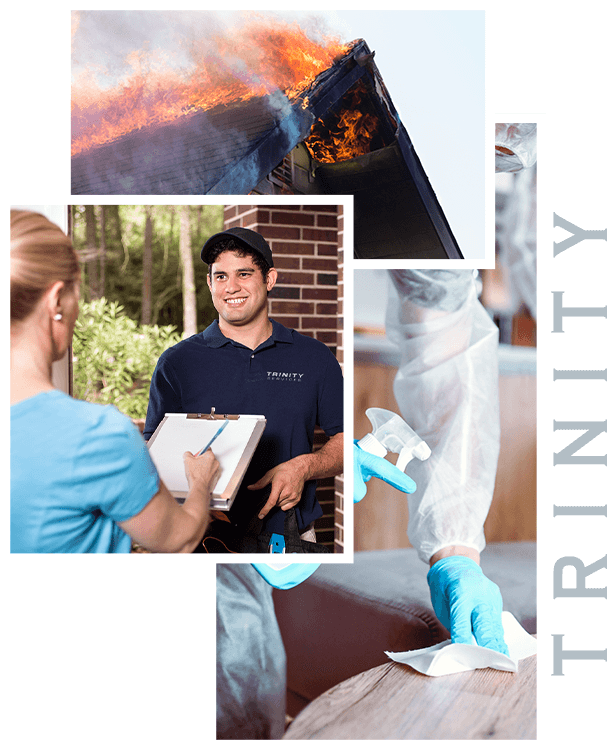
Storm Damage Roof Repair in Knoxville, TN
Your Premier Storm Damage Roof Repair and Cleanup Company In Eastern Tennessee
Has a storm damaged your roof? Trinity Services is the local, family-owned roofing company to call! Our roofing contractors are dedicated to providing you with cost-effective solutions while maintaining superior craftsmanship and service quality. We’ve been helping our community with storm-related roof repair, restoration, and replacement for over ten years and are ready to put our experience and resources to work for you! Our Knoxville team can help you understand what your roof needs in the aftermath of a storm and work together with your insurance company to make this process as easy and stress-free as possible.
What to Check on Your Roof After a Storm
After a storm has passed, it’s always a good idea to visually inspect your roof for damage. This can help you catch issues early and prevent costlier repairs down the line.
You may need to perform this inspection from the ground. If there are downed power lines, unstable debris, or any signs of structural damage to your home, it’s best to request and wait for professional help rather than climbing a potentially dangerous or unstable roof and risking your safety.
Here are the key areas to focus on when conducting your post-storm inspection:
- Shingles. Check for missing, cracked, or curled shingles. High winds can dislodge shingles, leaving your roof vulnerable to leaks. Also, look for any granule loss, which can indicate aging shingles that need replacement.
- Flashing. Inspect the metal flashing around your vents, chimneys, and valleys. Ensure there aren't any gaps or signs of rust that could allow water to seep in. Damaged flashing should be resealed or replaced immediately.
- Gutters and downspouts. Confirm your gutters and downspouts are clear of debris. Blocked gutters can cause water to pool on your roof or overflow, leading to structural damage. Look for any dents or bends caused by hail or falling branches.
- Drainage. Check your roof's drainage systems (if applicable) to verify they are functioning correctly. Stagnant water can lead to leaks or structural issues over time.
- Pipes and vents. Examine any plumbing vents or other roof protrusions for signs of damage or dislodgment. Ensure that the rubber gaskets around these features are intact.
- Overall structural integrity. Assess the overall condition of the roof's framework from the attic. Look for any signs of water stains, mold, or sagging, which could indicate leaks or structural compromise.
If you spot any potential issues or if you’re uncertain about your roof’s condition, we encourage you to reach out to us for storm damage roof repair in Knoxville. Our roofing contractors can help identify problems that may not be immediately visible, and we can install emergency tarping if we cannot complete needed repairs immediately.
When you need storm damage roof repair in Knoxville, contact us online or call (865) 459-2365 to request a free quote!
-
We Give A Free QuoteOur team knows that finding the best value is your priority. We will provide a fair damage assessment.
-
We Do the Hard WorkOur company works hard to ensure a job is done right in a timely and efficient manner, without shortcuts.
-
You Enjoy the ResultsTake pride in knowing your property has been properly repaired by Knoxville’s experts.
Does Insurance Typically Cover Storm Damage to Roofs in Tennessee?
In Tennessee, homeowners' insurance policies generally cover storm damage to roofs, but the extent of coverage can vary based on the specifics of the policy and the type of storm that caused the damage. Most standard policies include coverage for damage caused by harsh weather events like hail, wind, and lightning, which can lead to the loss of shingles or structural issues. However, you should review your specific policy for any exclusions or limitations.
Additionally, many insurance providers require policyholders to take reasonable steps to maintain their roofs to qualify for claims on storm damage. In the event of roof damage in Knoxville, you should thoroughly document the damage and promptly contact your insurance provider to initiate the claims process.
How Can I Prepare My Roof for a Storm?
Are you worried about how your home will handle the next inevitable storm? Preparing your roof for severe weather can significantly mitigate the risk of damage and help keep your home safe and secure.
Here are several steps you can take to help protect your roof from storm damage:
- Inspect and repair your roof ahead of time. Before storm season arrives, conduct a thorough inspection of your roof. Take the time to schedule minor repairs, such as replacing damaged shingles and resealing flashing around vents and chimneys. Early repairs can prevent more extensive damage when a storm hits.
- Clean gutters and downspouts. Clear your gutters and downspouts of leaves, debris, and any obstructions to maintain proper water drainage. Clogged gutters can cause water to back up onto your roof, increasing the risk of leaks and structural damage.
- Trim overhanging branches. If you have trees near your home, trim back any branches that may hang over your roof. In fierce winds, these branches can break and cause significant damage to your roof’s surface.
- Secure loose items. Make sure any loose items in your yard and on your roof, such as satellite dishes or vents, are secured properly. Items that aren't secured can be dislodged in high winds and turn into projectiles.
- Check attic ventilation. Proper ventilation in your attic can help prevent moisture build-up, which can lead to mold and rot. Make sure that your vents are clear and functioning properly so that air can circulate effectively.
- Consider reinforcements. Depending on the age and condition of your roof, you may want to take additional steps to reinforce your roof structure. This could involve hiring our team to install additional roof straps (which can secure better secure structure against extreme winds) or impact-resistant shingles designed to withstand harsh weather.


Hear from our happy customers
-
“We were very happy with the service from Trinity Restoration, they were very prompt, professional and completed the work fast and effective.”- Kara M.
-
“Within days my house was bone dry and livable. They called every step of the way to see how things were progressing.”- Sandi B.
-
“I have hired a lot of companies in my time and I have never experienced this level of commitment to deliver excellent service and communication from start to finish of the job being done.”- Brandon M.
-
“Great experience working with Trinity! Jason, Jammie, Dana, the entire crew is fantastic!”- Michael B.
Types of Storm-Related Roof Damage

Various aspects of a major storm can compromise your roof’s integrity. Knowing the specific threats these elements can pose can help you understand what to look for when you inspect your roof after the storm passes.
Heavy Rain
When rainwater accumulates on flat or low-sloped roofs, the pooling water can cause leaks and structural wear. The sheer force of heavy rain can exacerbate your roof’s existing vulnerabilities, such as loose shingles or flashing, causing them to lift or become dislodged. Persistent heavy rain can lead to erosion of your roofing materials, which diminishes their protective qualities. If your gutters are clogged, the excess water can overflow, damaging your roof's edges and allowing moisture to seep into your home’s underlying structures.
High Winds
Aggressive winds can pose a significant threat to the integrity of your roof, often resulting in damage that can be both immediate and long-lasting. Strong winds can lift your roof’s shingles: As winds gust underneath, they can create a pressure difference that may cause shingles to become loose or dislodged entirely. This not only exposes the underlying roofing material to potential leaks but also leaves your home vulnerable to further damage from subsequent weather events. Additionally, high winds can launch debris, such as branches, into your roof, leading to punctures and abrasions that compromise its protective layer. Prolonged exposure to high winds can also weaken and fatigue your roof's structure, making it more susceptible to damage over time.
Hail
Sustained hail can dent and pit your roof’s shingles, especially those made from asphalt or wood. These impacts can break the protective granules on shingles, reducing their ability to reflect UV rays and increasing the risk of heat-related deterioration. Hail also can cause cracks in your home’s roofing materials, leading to leaks that may worsen over time. For metal roofs, hail can create unsightly dings and even cause disconnection in seams or structural components. Flat roofs are not immune either, as hail can lead to punctures that compromise their waterproofing systems.
Fallen or Thrown Trees
Dislodged trees can cause significant and often catastrophic damage to your roof, representing one of the most serious threats during severe weather events. When high winds or storms uproot trees, they can crash down onto roofs, resulting in immediate impact damage that can puncture roofing materials or create large holes. The weight of the tree can compromise the structural integrity of your roof, leading to collapse in some cases. Additionally, branches can scratch or scrape the surfaces of your roofing materials, causing long-term issues such as leaks and further deterioration. Beyond the physical damage, the presence of tree debris can hinder proper drainage, leading to pooling water and an increased risk of water-related damage. You should promptly remove any fallen trees and watch out for any signs of roof damage, as even minor impacts may require a professional inspection.
Tornadoes
While tornadoes are fairly rare in Knoxville, they do pose an extreme threat to the integrity of your roof when they do appear. They are capable of causing catastrophic damage that can compromise the entire structure of your home. The intense winds associated with tornadoes can easily lift off your roof’s shingles and even entire sections of roofing. This wind can expose your roof’s underlying materials to further elements, increasing the risk of leaks and structural failure. Tornadoes can also introduce large debris, such as tree limbs and other heavy objects, that may collide violently with your roof, causing punctures, deep dents, or even penetrating through to your home’s interior. The swirling winds may also create a pressure imbalance, leading to a phenomenon known as “uplift,” which can tear off your roof or severely weaken its support structure. You must schedule an immediate professional inspection in the aftermath of a tornado, even if the damage seems relatively minor. The structural harm may be worse than you realize.
Better safe than sorry if you think you may need storm damage roof repair in Knoxville. Call our 24/7 emergency line at (865) 459-2365 or contact us online today!